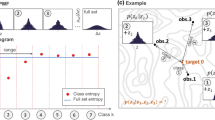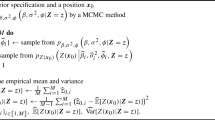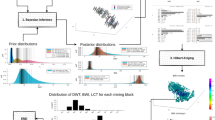Abstract
Geostatistics applied to radiological evaluation of nuclear premises provides sound methods to estimate radiological activities, together with their uncertainty. Quantification and risk analysis of contaminated areas are initially performed by applying geostatistical methods relying on the multi-Gaussian assumption. However, the application of the classical bi-Gaussian model for disjunctive kriging proves sub-optimal due to the spatial structuring of high and low values. The beta model which pertains to the class of Hermitian isofactorial models is potentially better suited to radiological evaluation as it allows a continuous evolution from a mosaic to a pure diffusive model. In the test case, disjunctive kriging estimates are obtained by applying in turn the beta model and the pure diffusive model. The comparison of estimation outcomes shows rather limited differences, primarily located in and around the homogeneous contaminated areas.
Similar content being viewed by others
Avoid common mistakes on your manuscript.
1 Introduction
For more than a century, the development of the French nuclear industry has led to the construction and exploitation of hundreds of facilities to produce nuclear fuel, burn it in experimental reactors or nuclear power plants, and eventually recycle it. Dozens of these facilities are now under decommissioning.
The complete decontamination of nuclear facilities requires the radiological assessment of residual activity levels of building structures. As stated by the International Atomic Energy Agency (2001): “Segregation and characterization of contaminated materials are the key elements of waste minimization.”
In this framework, the relevance of the geostatistical methodology relies on the presence of a spatial continuity for radiological contamination, characterized through the variographic analysis. Geostatistics then provides reliable methods for activity estimation, uncertainty quantification and risk analysis (Goovaerts 1997), which are essential decision-making tools for decommissioning and dismantling projects of nuclear installations. For less than a decade, geostatistics has successfully been used for the radiological evaluation of contaminated sites (Dubot et al. 2010) but nothing exists, to the best of the authors’ knowledge, for its application to nuclear facilities.
The paper first summarizes the geostatistical methodology applied to a former nuclear facility and its added value for waste categorization. Then it focuses on a more theoretical issue which lies in the implementation of isofactorial models to deal with the observed spatial structuring of high and low values, which contradicts the convenient multi-Gaussian hypothesis prompting the use of alternative geostatistical models.
2 Categorization of radiological waste
For confidentiality reasons, all data presented in the paper have been multiplied by a constant value in order to conceal the real radiological levels. However, this modification does not change the spatial structure analysis.
2.1 Evaluation methodology
Decommissioning and dismantling projects are largely affected by the quality of the investigation phase, which has significant impacts on the estimated risk levels and waste segregation optimization. The quality and the number of data can strongly improve or deteriorate the risk analyses, affecting global remediation costs (Desnoyers et al. 2009).
The proposed methodology for the radiological characterization of contaminated premises is divided into three steps according to the three available levels of information:
-
1.
First, the most exhaustive facility analysis provides historical and qualitative information: functional analysis, incidents, isotopy;
-
2.
Then, a systematic (exhaustive or not) control of the radiation signal is performed by means of in situ measurement methods such as surface control device combined with in situ gamma spectrometry; and
-
3.
Finally, in order to assess the contamination depth, samples are collected at several locations within the premises and analyzed.
Combined with historical information and radiation maps, the analysis of activity levels improves and reinforces the preliminary waste zoning required by the French Nuclear Safety Authority (Autorité de Sûreté Nucléaire 2010).
2.2 Investigated area
The “Atelier D” is one of the four workshops of the ATUE facility, Cadarache CEA Centre (Lisbonne and Seisson 2008). For 30 years, it was used for the recycling of uranium contained in different non irradiated scraps so as to transform it into nuclear purity products (mainly oxides) by liquid processes. The 235U enrichment was less than 10%.
The workshop area is about 800 m². The different processes were located in several rooms distributed along a central corridor. All the process equipments have already been dismantled whilst the building structures (mainly concrete) remain to be characterized and cleaned up.
The functional analysis provides a well-documented workshop organization (processes, liquid flows…) and distinguishes two types of processes according to the nature of the uranium product: liquid phase or solid state. The historical analysis points out a few contamination incidents during the industrial exploitation that left a residual radiological contamination essentially located on the floor.
2.3 Experimental data
In 2008, an extensive non-intrusive measurement campaign was carried out using surface detection systems and in situ gamma spectrometry. This is the second step of the characterization methodology, which is a key element for the analysis of the contamination extension and also for the optimization of destructive investigations.
Surface measurements are realized with thin-layer plastic scintillation detectors for α and βγ-radiation. Measurement values are proportional to gross counting rates (cps). The paper focuses on βγ-radiation as the presence of varnish makes the α-radiation values inaccurate. Uranium is the only radioactive element within the building and is therefore characterized using the βγ-radiation of its decay products.
A regular 66 cm mesh leads to the realization of 1,617 measurement points on the floor (Fig. 1). The investigations carried out on the workshop walls and on specific areas are not presented here.
The statistical distribution (Fig. 2) of βγ-radiation shows a strong dissymmetry with a few very high values and a lot of values around the background noise where there is no contamination. The distribution is presented using a log scale in order to better capture the range of radiation measurements.
In order to complete the radiological evaluation of the workshop, 1-cm depth concrete samples have been collected in 2009 from scabbling performed at 56 locations within the premises, determined on βγ-radiation maps.
2.4 Radiological evaluation using geostatistics
Quantification of contaminated surfaces is performed by applying activity thresholds on conditional geostatistical cosimulations between uranium activity levels of sparsely collected concrete samples (principal variable) and radiation levels of the more numerous surface measurements (auxiliary variable). The adherence to the multi-Gaussian hypothesis which underlies the generation of these cosimulations is specifically challenged in paragraph 3.
The remediation support constraint is taken into account by considering the different workstation areas as effective remediation supports. Using the simulations, the probability of exceeding a given activity threshold within each area is computed (Fig. 3) leading to an effective cost-benefit analysis.
Desnoyers et al. (2009) described in details the application of the geostatistical methodology with this dataset with a particular emphasis on sampling optimization according to spatial structure and historical information (liquid phase or solid state).
3 Structuring of extreme values
3.1 Isofactorial models for disjunctive kriging
Isofactorial models offer an efficient representation of bivariate distributions that allow the description of a diverse range of situations. The most commonly used isofactorial model in geostatistics is the bi-Gaussian model along with its generalization to the Hermitian model (Chilès and Delfiner 1999). Both require a Gaussian marginal distribution. Since the variable Z(x) under study does not conform to that requirement, a preliminary Gaussian transformation of the data is performed. This amounts to considering Z(x) in the functional relationship Z(x) = φ[Y(x)] where Y(x) is a variable obeying a standard normal marginal distribution and φ a transform function (anamorphosis). The Gaussian transformation is usually done by identifying quantiles of the empirical distribution of Z with the corresponding quantiles of the standard normal distribution. The function φ is then classically expressed by its expansion into Hermite polynomials H p , using the φ p expansion coefficients:
Since the Hermite polynomials are orthogonal with respect to the standard normal probability density function, they simplify the use of the Hermitian model. Indeed, the disjuncstive kriging (DK) of φ[Y(x)] in Eq. 1 amounts to the simple kriging (SK) of each factor (Rivoirard 1994):
3.2 Spatial structuring of extreme values
The Hermitian model comprises a range of bivariate distributions going from the mosaic to the pure diffusive model (Chilès and Delfiner 1999). The isofactorial model is specified once the covariances T p (h) of the factors H p are known. In fact, with ρ(h), the correlogram of the Gaussian Y(x), we already have T 0 (h) ≡ 1 as H 0 [Y(x)] ≡ 1 and T 1 (h) ≡ ρ(h) as H 1 [Y(x)] = –Y(x).
In the case of a bi-Gaussian (pure diffusion) model, T p (h) = ρ p(h). The covariances of the factors tend to a pure nugget effect when p increases. The high and low values are totally spatially destructured.
On the contrary with the mosaic model (random partition), all factors have the same covariance T p (h) = ρ(h). There is no spatial destructuring of extreme values.
Between these two limiting cases, the beta model is a mixture of the pure models associated with a positive correlation coefficient. More precisely, the correlation ρ(h) between Y(x) and Y(x + h) is obtained by a mixture of Gaussian bivariate distributions whose correlation r follows a beta distribution with parameters βρ(h) and β(1-ρ(h)), where β is a positive parameter. Thus, given Γ the gamma function, the covariances T p (h) are:
Figure 4 shows the covariance of the tenth factor when ρ(h) follows an exponential model with unit sill and a range of 8 m; the mosaic model corresponds to β = 0, and the pure diffusive model is obtained when β tends to infinity. An intermediate situation for β = 2.5 is also presented. Thus, the beta model allows a continuous evolution from the pure diffusive to the mosaic model.
This modeling of the spatial structuring of extreme values with isofactorial models within the geostatistical framework differs from the classical terminology used in spatial statistics for extreme events having a very low probability of occurrence (see Sang and Gelfand 2009 for example). In our case, it refers to the “destructuring” effect mentioned in Emery (2005) whereby low values and high values tend to be better correlated than intermediate values. Taking this phenomenon into account is the main goal of the (isofactorial) beta model.
3.3 Bivariate distribution and β parameter
In practice the infinite series of factors in the development of the transform φ shall be truncated to some order. Calculations are based on the decimal logarithm of the raw data. Since its distribution is not so far from a Gaussian one, only a few polynomials are required: the φ p coefficients from Eq. 1 become rapidly negligible when p increases (Table 1).
The choice of the isofactorial model can be guided by the study of the variogram of order 1 (or madogram) defined as follows:
In the case of a bi-Gaussian model, the madogram and the variogram are linked through the formula: \( \sqrt \pi \gamma_{1} (h) = \sqrt {\gamma (h)} \) (Lajaunie 1993). As shown on the left part of Fig. 5, this relationship is not satisfied. Within the mosaic model, the madogram and the variogram are proportional, which is not the case either.
Test for bi-Gaussian distribution (left) the square root of the variogram divided by the madogram is expected to be equal to \( \sqrt \pi \) whatever the distance. Relationship between the variogram and the madogram with a beta model (right). The extremes correspond to the pure diffusive model (parabola) and to the mosaic model (straight line)
Thus the beta model is required and the experimental points of the Gaussian transformation of βγ-radiation values perfectly fit with a β parameter equal to 2.5 (right part of Fig. 5). Through this graph, the inference of the β parameter is quite easy to perform.
3.4 Comparison of isofactorial models
In Fig. 5 the beta model with β = 2.5 does not look very different from the bi-Gaussian model (infinite β value). The following analysis bears on the comparison of disjunctive kriging estimates obtained in turn for a beta model with β = 2.5 and then for a bi-Gaussian model.
In order to compare the estimation results, 4 partial sampling patterns are extracted from the complete βγ-radiation dataset assuming that 1 measure out of 4 is unknown. For each subset, the hidden points are regularly spaced and are re-estimated as validation points using the remaining data (3/4). Results are presented by gathering together the 4 quarters of re-estimated values.
The linear regression between factors of the same order is particularly significant: the regression coefficients lie between 0.994 and 1. The main difference between the bi-Gaussian model and the beta model is the slope of the linear regression of the SK of each factor (Table 2). The beta model (β = 2.5) systematically re-estimates wider ranges of values.
The simple kriging estimates H SK p of the factors H p at the validation point x are combined according to relation (1) to give the disjunctive estimate of the decimal logarithm of βγ-radiation levels. Estimation errors are very similar in both models: the linear correlation is almost perfect with a regression coefficient equals to 0.99991. The standard deviation of the difference between the two disjunctive kriging estimates is 42.5 times smaller than the standard deviation of the difference between one of the disjunctive estimates and the true value (Fig. 6). Note that it is also possible to perform the disjunctive estimate of the βγ-radiation level rather than its logarithm, or of any function of it, for example the indicator associated with a given threshold: the H SK p remain and only the φ p of Table 1 have to be adapted.
Figure 7 illustrates the spatial repartition of the difference between the two DK estimates. Beta model DK estimates seem to systematically lie above the bi-Gaussian model DK estimates in areas with elevated βγ-radiation levels.
4 Conclusions
In the case of radiological characterization, the spatial continuity of extreme values may bias the estimation of high values in particular, which is a relevant issue for decommissioning purposes.
Conventional geostatistical calculations are usually performed relying on the traditional and rather convenient multi-Gaussian model. In this work, the structuring of extreme values, which clearly contradicts the multi-Gaussian hypothesis, is taken into account in a coherent manner by the use of the more general class of Hermitian isofactorial models, in particular the beta model. In our test case, the β parameter, which models the structuring effect, leads to a practical modeling not too dissimilar with the modeling offered by the classical bi-Gaussian model. The comparison between the two competing disjunctive kriging estimates further supports this finding by showing very minor differences. In that way, the multi-Gaussian model can still be considered as a reasonable approximation leading to robust estimates as long as the structuring effect (of high or low values) remains limited (i.e. when the departure from optimal conditions for the multi-Gaussian hypothesis is not pronounced).
The final interest of such isofactorial models is their ability to deal with change-of-support problems, in the framework of their extensions: the discrete Gaussian (or gamma) change-of-support models. The impact of the structuring effect of extreme values on estimations of the probability of having an activity level exceeding a threshold shall be investigated taking both a punctual and a block support into account.
Finally, the indicator variograms present an asymmetry with respect to the median threshold, indicating a different structuring effect for high values and for low values. A transformation to a gamma distribution should therefore be more suited than the Gaussian one (Emery 2005). This point shall also be investigated.
References
Autorité de Sûreté Nucléaire (2010) Méthodologies d’assainissement complet acceptables dans les installations nucléaires en France, Projet de guide de l’ASN n° 14, ASN, Paris
Chilès JP, Delfiner P (1999) Geostatistics: modeling spatial uncertainty. Wiley, New-York
Desnoyers Y, Chilès JP, Jeannée N, Idasiak JM, Dubot D (2009) Geostatistical methods for radiological evaluation and risk analysis of contaminated premises. In: Proccedings of Sien 2009 Symposium, Bucharest
Dubot D, Desnoyers Y, de Moura P, Attiogbe J, Jeannée N, Péraudin J-J (2010) Characterization of radio-contaminated soils in France: challenges and outcomes. In: International Conference Intersol 2010, Paris, France
Emery X (2005) Conditional simulation of random fields with bivariate gamma isofactorial distributions. Mathematical Geology, 37
Geovariances (2010) Isatis technical references, version 10.0
Goovaerts P (1997) Geostatistics for natural resources evaluation. Oxford University Press, New York
International Atomic Energy Agency (2001) Methods for the minimization of radioactive waste from decontamination and decommissioning of nuclear facilities, Technical Reports Series No. 401, IAEA, Vienna
Lajaunie C (1993) L’estimation géostatistique non linéaire. Lecture Notes C-152, Centre de Géostatistique, Fontainebleau
Lisbonne P, Seisson D (2008) Enriched uranium workshops towards decommissioning Cadarache nuclear research centre. International conference on decommissioning challenges: an industrial reality?, Avignon
Rivoirard J (1994) Introduction to disjunctive kriging and non-linear geostatistics, Clarendon. Oxford University Press, Oxford
Sang H, Gelfand AE (2009) Continuous spatial process models for spatial extreme values. J Agri Biol Environ Stat 15(1):49–65
Acknowledgments
All geostatistical calculations and most graphics are realized with the Isatis software (Geovariances 2010). This work is supported by Geovariances and the Geostatistics Group of Mines ParisTech. Besides, an industrial partnership with CEA partially funded the work and gave the access to nuclear facilities.
Author information
Authors and Affiliations
Corresponding author
Rights and permissions
About this article
Cite this article
Desnoyers, Y., Chilès, JP., Dubot, D. et al. Geostatistics for radiological evaluation: study of structuring of extreme values. Stoch Environ Res Risk Assess 25, 1031–1037 (2011). https://doi.org/10.1007/s00477-011-0484-6
Published:
Issue Date:
DOI: https://doi.org/10.1007/s00477-011-0484-6











